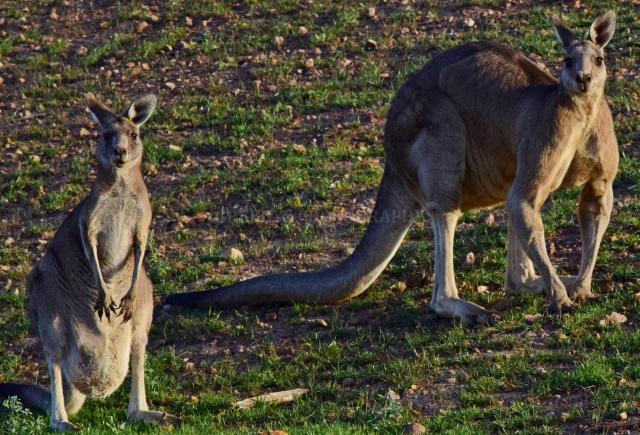
By Tyler Wright
Just over a third of kangaroos relocated from a development site in Lilydale have survived after being released into Warramate Hills Nature Conservation Reserve in Gruyere.
Around 40 Eastern Grey Kangaroos who made the Kinley Estate site home were moved to make way for the build, with developers Intrapac Property reaching out to Melbourne University School of BioSciences Associate Professor Graeme Coulson to lead a translocation study.
At an Arthur Rylah InstItute presentation on 22 May, Dr Coulson revealed that soon after the kangaroos’ release in August 2021, three had drowned in the Woori Yallock Creek, with others falling victim to fences, gun shots and road crashes in the months following.
The survival rate in the first year was just 41-47 per cent, and now only 38 per cent of the group remain alive, Dr Coulson said.
“By the end of the first year, at least half of them had left the site and they’ve gone some very big distances in some cases…one of them has gone 25 kilometres,” Dr Coulson said.
“Three… we don’t know what happened to them, they’re simply missing. If we counted those as also dead, the survival would be poorer.”
After community outcry in 2020 when it was revealed the kangaroos would be shot, veterinarians and wildlife experts came together to form a working group called Save the Kinley Kangas (STKK), which has since been reorganised as the Victorian Kangaroo Alliance (VKA).
A statement from the VKA stated a soft release proposal from the group’s experts was submitted to Intrapac Property, but was abandoned in favour of Mr Coulson’s plan.
“We predicted a terrible outcome because of this experiment’s methodology, and sadly our fears have been realised,” VKA president Alyssa Wormald said.
“Kinley was an opportunity to document the known benefits of soft release, and we are devastated that instead the kangaroos were subjected to stress, suffering and death that we believe was largely avoidable,” Ms Wormald said.
“I was shocked that the alternative of soft release was not even mentioned in the presentation.”
Dr Coulson said the soft release method of keeping the kangaroos in a holding yard at the release site before their hard release was considered by the university’s ethics committee, but was ruled out due to the potential risk of the animals contracting a serious stress-induced disease called capture myopathy.
“We were approached by the developer….and then we put together a team of people, partly from the uni, but also outside, and that gave us the people we needed to do the capture, the transport and the monitoring,” Dr Coulson said.
“The monitoring has been quite intense, we monitor[ed] them every day for the first couple of weeks after they are released and this was staggered over time because the releases didn’t all happen immediately together, then we did it twice a week and now we’ve dropped back to once a fortnight as things have settled down. ”
Dr Coulson said there is not a lot known about the translocation of kangaroos, with two previous studies showing “poor” survival rates for the animals.
“The first of these comes from the Gold Coast some years back, a place called Harbour Town.. very small sample, just had some 13 kangaroos… 23 per cent mortality during capture, so three of the 13 died while they were being attempted to catch,” he said.
“The second study that’s been published is one from Western Australia…41 per cent of these animals died during capture and then survival after capture was pretty bad too… it works out to 9 per cent survival in one year.”
A spokesperson from the state government’s Conservation Regulator told the Star Mail the regulator issued a research permit under the Wildlife Act in 2021 to translocate kangaroos from the Kinley development site in Lilydale.
“Limited research is available on kangaroo translocation in Victoria and the decision to issues the research permit was to support building understanding of whether kangaroos can be translocated in a way that achieves an acceptable animal welfare outcome,” the spokesperson said.
“The research permit includes strict guidelines to ensure animal welfare, including only handling kangaroos in specified circumstances and monitoring the translocated kangaroos for three years.”
“We understand that there has been significant mortality of kangaroos through the research project. This data will inform the assessment of future requests for kangaroo translocation.”
Manfred Zabinskas OAM BSc (Environmental Management) from Five Freedoms Animal Rescue said the suggestion that kangaroos are better shot than relocated is based largely on mortality resulting from factors such as “poorly managed recovery, illegal shooting and interference from dogs”.
“As a scientist, I do not accept that a conclusion of failure is warranted, and as an expert in kangaroo rescue and behaviour, I believe this study offers hope for further research into successful kangaroo translocation,” Mr Zabinskas said.
“These trial results show significant improvement over previous attempts and lays a solid basis for further improvements on methodology, particularly utilising soft release, and a more considered choice of release location.”
Four kangaroos are alive at the Warramate Hills Nature Conservation Reserve.
Intrapac Property did not respond to Star Mail’s request for comment before deadline.







